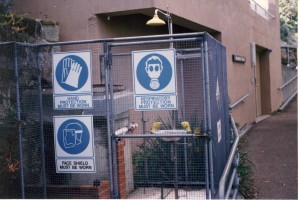August 12, 2012
 Warning labels. We find them on so many things. And we too often ignore them. But parents are devoted to knowing what dangers face their children. So parents often read warning labels that have to do with products they might purchase for a son or daughter. Such warnings appear on bicycle safety helmets. The CDC notes that,
Warning labels. We find them on so many things. And we too often ignore them. But parents are devoted to knowing what dangers face their children. So parents often read warning labels that have to do with products they might purchase for a son or daughter. Such warnings appear on bicycle safety helmets. The CDC notes that,
“Three organizations — ANSI, the Snell Memorial Foundation, and the American Society for Testing and Materials (ASTM) — have developed voluntary standards for bicycle helmets Table_1. Helmets are tested for the amount of impact protection they provide by dropping the upper torso and helmeted head of a crash-test dummy (i.e., a “helmeted headform”) onto a metal anvil and measuring the amount of force on the headform (22). Testing for strap-system strength is done by dropping a weight on the fastened strap; the weight causes weaker strap systems (i.e., straps or buckles) to break. Helmets that meet Snell standards provide better protection against bicycle- related head injury than do helmets that meet the less rigorous ANSI standards (18). The Consumer Product Safety Commission is developing federal standards for bicycle helmets. These standards will apply to all helmets sold in the United States and will most likely be similar to the existing standards.
All three existing standards require that manufacturers include warning labels that advise consumers that helmets are for bicycle use only (e.g., “not for motor-vehicle use” {23}) (24, 25). In addition, manufacturers are required to warn consumers (e.g., by including a warning label in the helmet) that a) a helmet that has sustained an impact should be returned to the manufacturer for inspection or be destroyed and replaced, and b) helmets need to be fitted and securely fastened to the bicyclist’s head to provide maximum protection”
Some research and experience begins to suggest that perhaps a warning label should appear on children’s backpacks. Some backpacks used for recreational backpacking have warning labels
Some children’s backpacks have warning labels because the material that the pack is made from includes content known to be a cause of cancer. See this review for example:
“This item just arrived, a gift for my 2 year-old son. He was thrilled when he saw it. It was therefore terribly upsetting to discover the following warning (in tiny print) on one of the product labels: “WARNING: This product contains chemicals known to the State of California to cause cancer and birth defects or other reproductive harm.” This warning follows the requirements of California Proposition 65 (ample material about it on the web). This warning is, of course, unacceptably vague. However, no caring parent would risk exposing their child to a toxic substance. This morning, my son woke up asking for his backpack. I am saddened, angered, and frustrated that he and I have been put in this position by inadequate regulation of toy safety (the backpack is made in China) and inadequate disclosure (both on the toy tag and on the Amazon website) identifying the specific potential risk” [http://www.cdc.gov/mmwr/preview/mmwrhtml/00036941.htm].
Consumer reports suggests that the size of the backpack, including how far down on a child’s back it falls and the width of straps, is important for the comfort of the pack for your child. For a full review of things to consider, see the report at: http://shopping.yahoo.com/news/how-to-pick-a-backpack-for-your-child-.html
Happy back to school shopping!

 November 22, 2010
November 22, 2010 November 16, 2010
November 16, 2010 Warning labels provide another way that policmakers are trying to assure that we have information to protect our health. Warning labels are designed to get our attention with a signal work about a hazard: caution, danger, or often–warning. The label also includes a statement about what makes the product risky. For example, if it contains alcohol, then it may be flammable. If it contains an herb, it may interact with prescribed medication or the drug to be used for your medical procedure. The label may also include a way to avoid the harm, such as talking with your doctor about using the product. And it may include content about outcomes that could occur, although these may be worded abstractly, such as–“adverse reaction”–meaning what exactly?
Warning labels provide another way that policmakers are trying to assure that we have information to protect our health. Warning labels are designed to get our attention with a signal work about a hazard: caution, danger, or often–warning. The label also includes a statement about what makes the product risky. For example, if it contains alcohol, then it may be flammable. If it contains an herb, it may interact with prescribed medication or the drug to be used for your medical procedure. The label may also include a way to avoid the harm, such as talking with your doctor about using the product. And it may include content about outcomes that could occur, although these may be worded abstractly, such as–“adverse reaction”–meaning what exactly?